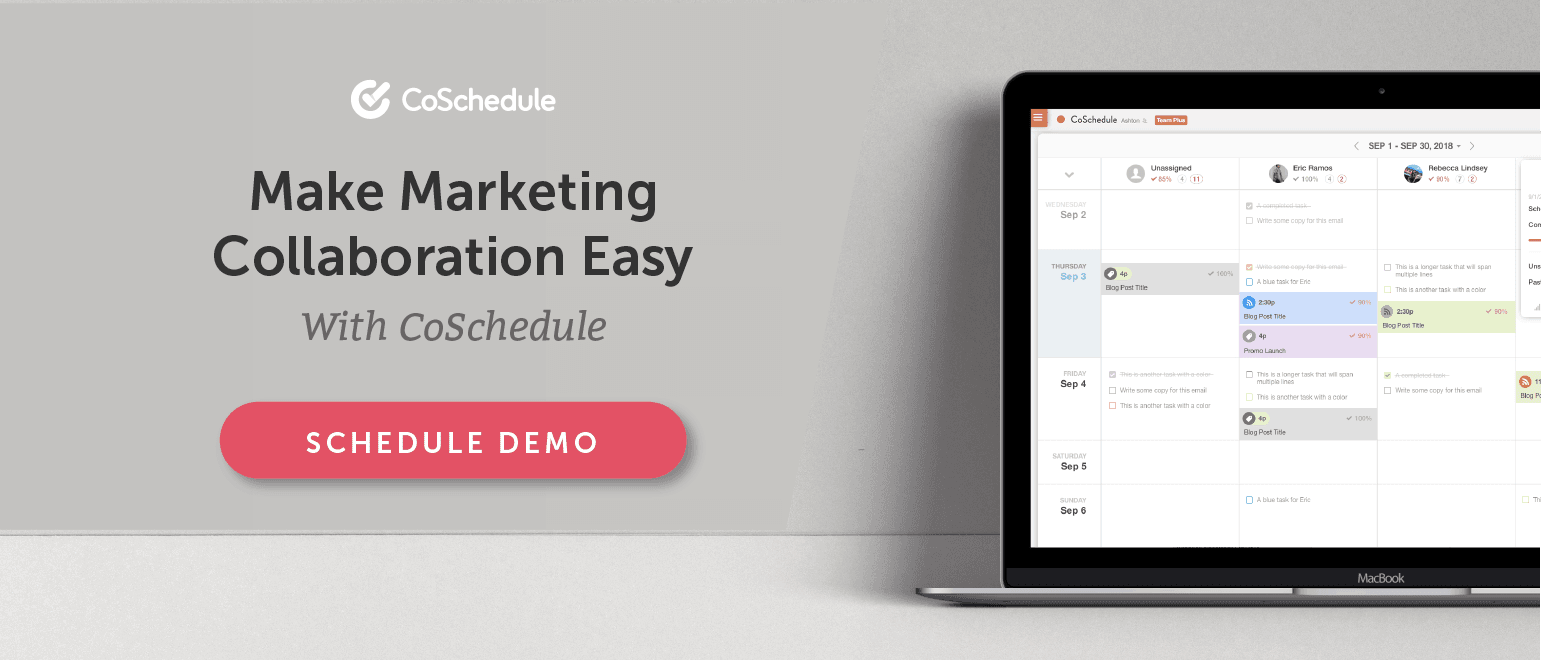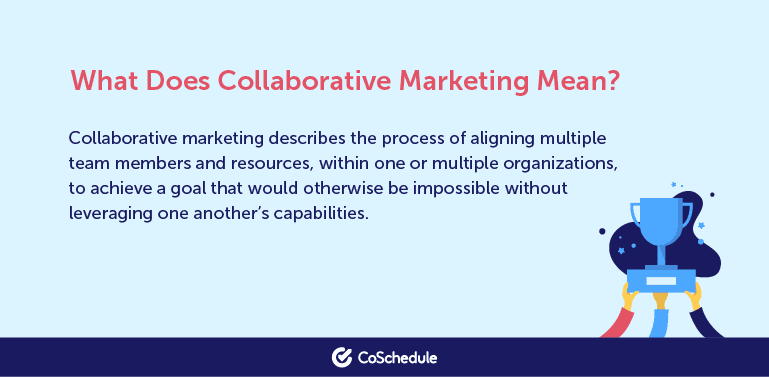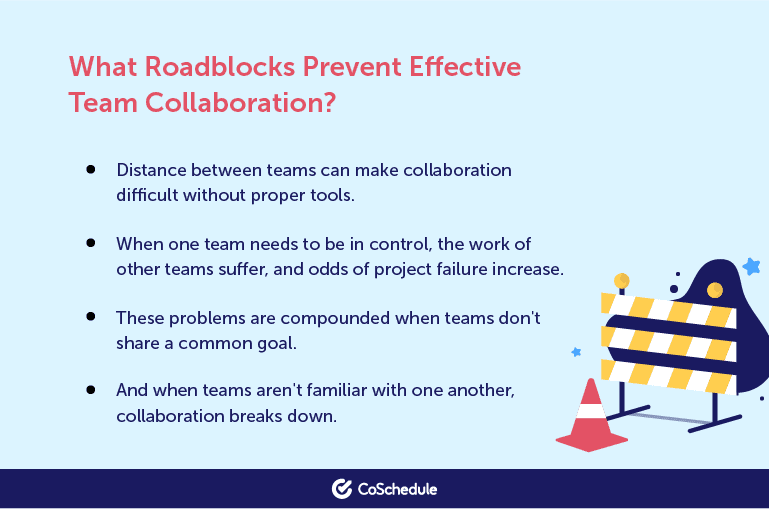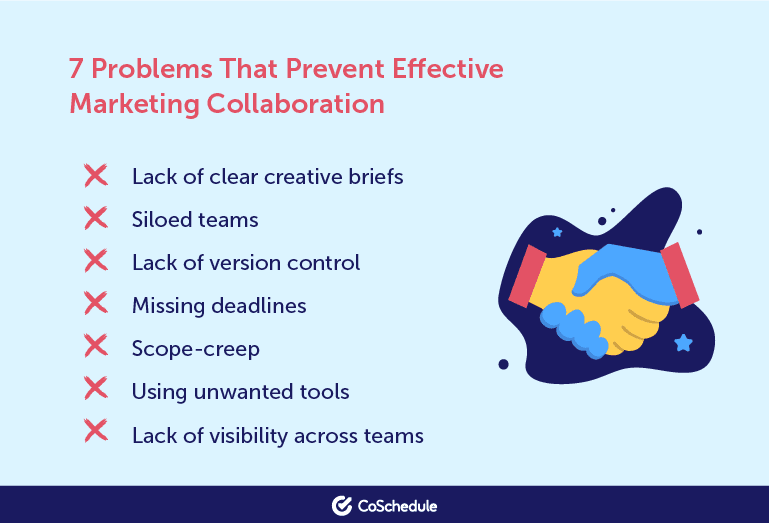How to Make Collaborative Marketing Actually Work the Best Way
 Marketing managers want their teams to collaborate effectively.
Facilitating collaborative processes between team members and across departments, however, is easier said than done.
The more people are added to a project, the more potential for productivity snags.
Increased complexity equals increased odds of project failure due to miscommunication, misalignment of resources, or general disorganization.
However, when managers, sales, creatives, strategists, and analysts are all working in sync toward a common goal, teams can achieve results far beyond what they could on their own.
In fact, maximizing success often requires this, and the complex needs of modern marketing make functioning optimally impossible without collaborating well across departments and disciplines.
Marketing managers want their teams to collaborate effectively.
Facilitating collaborative processes between team members and across departments, however, is easier said than done.
The more people are added to a project, the more potential for productivity snags.
Increased complexity equals increased odds of project failure due to miscommunication, misalignment of resources, or general disorganization.
However, when managers, sales, creatives, strategists, and analysts are all working in sync toward a common goal, teams can achieve results far beyond what they could on their own.
In fact, maximizing success often requires this, and the complex needs of modern marketing make functioning optimally impossible without collaborating well across departments and disciplines.

Download Your Free Marketing Collaboration Templates
Before tackling any task, it's useful to have the right tools for the job. To help implement more collaborative marketing strategies and processes in your own organization, download these three free resources:- Marketing Strategy Guide (PDF): Plan an entire marketing strategy efficiently (with team collaboration in mind from the start).
- Marketing Project Calendar Template (Excel): Collaborate on project timelines with a single version of truth.
- Convincing Your Team to Use CoSchedule (PowerPoint): CoSchedule is marketing management software that's built to facilitate collaborative marketing teams. Before you decide to use it with your organization though, you'll need buy-in from your team. This slide deck will help build the case for collaborating in one place with CoSchedule.
How to Make Collaborative Marketing Actually Work the Best Way by @Ben_CoSchedule
Click To TweetWhat Does Collaborative Marketing Mean?
Here’s the definition this post will work with:Collaborative marketing describes the process of aligning multiple team members and resources, within one or multiple organizations, to achieve a goal that would otherwise be impossible without leveraging one another’s capabilities.That sounds simple enough, right?

Why Does Effective Collaboration Matter?
The payoff for investing in collaborative skill development, training, software, and processes can be powerful. But, not all companies feel like their teams are working together well enough. According to a survey from Visix, 39% of those surveyed “believe that people in their own organization don’t collaborate enough.” That’s a massive problem.Almost 40% of people think their organization doesn't collaborate well. Do you agree?
Click To TweetWhat Are the Biggest Roadblocks to Effective Collaboration?
So, if companies aren’t collaborating enough, what’s holding them up? Speaking in terms of newsrooms (chaotic, busy places—not unlike marketing departments), Poynter once broke down four Ds that block creative collaboration:- Distance: Too much physical distance between teams.
- Dominance: One team’s ego and need to be in charge, crushing collaborative culture.
- Dissonance: Competing priorities between teams leading to la ack of clear focus.
- Discomfort: Sometimes, it’s challenging to work with people you don’t know.
 That article was written back in 2008. But, with the possible exception of the first point (teleconferencing technology has come a long way since then), the other three issues are timeless barriers to getting people to work well with each other.
Including marketers.
That article was written back in 2008. But, with the possible exception of the first point (teleconferencing technology has come a long way since then), the other three issues are timeless barriers to getting people to work well with each other.
Including marketers.
What stops your company from good collaboration? Here are 7 common roadblocks and how to solve them
Click To Tweet- Lack of clear creative briefs. Projects that don’t start with clear expectations will fail.
- Self-forming silos. If you don’t encourage collaboration, teams will clique together.
- Lack of version control. This sounds simple, but having a basic file naming convention and the right tools is huge for getting things done right and on time.
- Team members failing to hit deadlines. Knowing when deadlines are set, and being held accountable to them, sounds basic. Until deadlines get blown. Repeatedly.
- Scope-creep. Projects that don’t have clear expectations set at the beginning are liable to spiral out of control
- Using unwanted tools. Consolidate tools as much as possible and use what the team is most comfortable with.
- Lack of visibility across teams. Be sure to choose tools that help team members see every project, every upcoming deadline, and collaborate in one place (shameless plug: CoSchedule does all this and more, and it’s built specifically for marketing teams).

Breaking Down Collaborative Barriers: Start With Skills
On an individual level, marketers (and anyone else involved in working with or in a marketing department or adjacent discipline) need to know how to work well with others. This is not work that can be done in a vacuum. Here are some high-level skills that are key:- Interpersonal Communication
- Honesty
- Compromise
- Dependability
- Teamwork
- Delegation
 Without these basic personal and professional skills, there are no tools or processes will help (or at least they won’t help as much as they could). Take a deeper look at each area below.
Without these basic personal and professional skills, there are no tools or processes will help (or at least they won’t help as much as they could). Take a deeper look at each area below.
Interpersonal Communication
Everything starts with simply knowing how to talk to other people. That includes co-workers, clients, prospects, and anyone else with a vested interest in your company. Even if this is an area where you struggle, it’s something anyone can improve upon.Honesty
This, on the other hand, is harder to teach. Ideally, you’ll hire trustworthy people. But, it’s also important to foster a culture where open and honest communication is valued and encouraged.Compromise
With any collaborative effort, it isn’t always possible for everyone to get everything they want. So, understanding how to compromise is often essential for finding solutions and moving projects forward.- 7 Secrets for Better Compromises in the Workplace (Inc.)
- The Art of Compromise at Work (The Seattle Times)
- Compromising When Compromise is Hard (Harvard Business Review)
Dependability
Be someone others can count on. When you say you’ll do something, do it. When team members say they’ll do something, hold them accountable, too.- 10 Smart Ways to Become More Dependable and Organized (Inc.)
- 8 Ways to Become the Most Dependable Person in the Room (Inc.)
- How to Become a More Reliable Person (Lifehacker)
Teamwork
Successful collaboration requires everyone involved to be a team player, rather than any one side or collaborator attempting to take outsized credit for a project’s success.- When is Teamwork Really Necessary? (Harvard Business Review)
- 43 Inspiring Motivational Quotes About Teamwork and Collaboration (Inc.)
- 10 Surefire Tips to Improve Teamwork in the Workplace (Time Doctor)
Delegation
Leadership on any marketing project will require smart delegation to make sure the right people are working on the right things.- To Be a Great Leader, You Have to Learn to Delegate Well (Harvard Business Review)
- How to Delegate Effectively and Get More Done (6Q)
Marketing Collaboration Software and Tools to Consider
Getting team members, departments, and organizations to collaborate well will require having the right tools for the job. Here are some suggestions.CoSchedule + Team Management Dashboard
CoSchedule is a marketing management platform built to help teams get organized. Now, with the Team Management Dashboard, it’s easier than ever for teams to plan projects, manage tasks, and collaborate more effectively.Evernote
You probably know that Evernote is a popular note-taking app (and if you didn’t, the name probably gave it away). But, you might not know that it’s extremely useful for all kinds of other tasks, too. For marketers, it’s nearly indispensable for:- Storing shared documents. Google Drive is great, but things tend to get lost there.
- Planning meeting agendas. Same as above.
- Writing content. Evernote integrates with CoSchedule, which can convert Evernote documents into WordPress posts, which you can then schedule to publish automatically.
Gsuite (Docs, Sheets, Slides)
Have you ever tried working on a document by emailing it back and forth between multiple people? If you have, there’s one thing you know: it sucks. Fortunately, collaborative editing suites have become more the norm these days, making it much easier to work on content together. Plus, CoSchedule integrates with Google Docs to make document storage and collaboration even easier. You can also convert Google Docs into WordPress posts (thanks to its WordPress integration, too), PDF, or HTML.Who Needs to Collaborate?
As a marketer, you might find yourself in any of a number of different scenarios requiring collaboration. Between coworkers. With clients. Partnering organizations. Here are some common areas you might encounter.Writers and Designers
This classic pairing is as old as advertising itself. Writers craft copy and generate “big ideas.” Designers present those ideas visually in the best way to connect with audiences. Somewhere in between, though, there’s potential for creative disagreement. Without strong collaborative skills, that disagreement can turn into outright conflict. When both sides work well together, though, the results will show in their output. And investing in strong writer/designer relationships can pay dividends for years.Collaboration Between Cross-Functional Teams
In most companies, marketing teams will need to work with every other department at some point. Many of those teams will have no idea how to work with marketers. In those cases, don’t expect them to understand all your jargon. Or, really, anything about what you do at all. Instead, focus on how your team can make that working relationship easier by emphasizing learning what you can about their needs. Be flexible, be patient, and above all, be useful. Do so and you’ll find things move a lot more smoothly.Alignment Between Marketing and Sales Teams
Sales and marketing need each other to succeed. But they often don’t see eye to eye. Sales teams understand best what prospects and leads want, because they talk to those people every day. Marketers need to use that information when crafting messaging and campaigns that will motivate those leads to buy. But, when the two sides can’t see eye to eye on what real problems are, or when one side doesn’t fully understand the real value proposition of what you’re selling, or when any of a number of other common sources of disagreement crops up, things can break down.In-House and Agency Teams
Even the best agency/client agency relationships have some creative tension. For in-house teams, it’s important to remember they’re paying an agency to deliver expertise they don’t have in-house. Agencies, meanwhile, often struggle to admit they’ll never know their clients business as well as the client themselves. Bridging those divides can go a long way toward building positive collaboration between teams.Partnering Companies and Organizations
When two (or more) companies or organizations collaborate, the goal should be one of mutual benefit. But, when different companies have different ways of working, things can break down. And things can go sour fast when attempts aren’t made to accommodate one other. Some ways this can be alleviated include:- Use a common toolset. Pick a collaboration platform one or both or all sides use and agree to stick with it for managing your collaborative project.
- Again, be flexible. Don’t insist on rigidly doing things your own way.
- Focus on the goal. Hold up your end of the deal and work toward a shared win.
Implementing Collaborative Processes
So, how do you implement an actual process to facilitate effective collaboration? Consider following these steps.Only Include People Who Need to Be on Each Project
Ever get stuck in a meeting you didn’t need to be in? We all have, and it’s a major productivity killer. Before kicking off any project, figure out who is actually needed to get it completed.Keep Everyone Organized In One Tool
Effective collaboration starts with effective processes. And executing an effective process is easiest when technology actually helps support those processes, instead of getting in the way. While there are tons of tools out there that can achieve this goal, the CoSchedule team is biased toward, well, CoSchedule. That’s because it’s the best management platform that’s built specifically for marketing teams (as opposed to general task management or project management tools). Here’s a quick overview of what you can do:- Manage your entire team’s work and measure productivity. Plan every project on the same calendar, manage tasks with Task Templates, and measure productivity with Team Performance Reports.
- Provide visibility across teams. When everyone can see everything in one place, there’s no ambiguity around who is doing what.
- Fire makeshift marketing. Using multiple non-marketing specific tools leads to what’s called “makeshift marketing,” which leads to frustration and collaborative failure. CoSchedule makes it easy to consolidate and integrate tools to get everyone organized and streamline workflows.

Write Clear Creative Briefs
Every project should start with clearly defined expectations and goals. This helps achieve a few different outcomes:- Communicating project needs and setting clear expectations. Clearing up ambiguity, establishing requirements, and documenting boundaries helps make sure deadlines get met, work is executed properly, and scope creep is kept in check.
- Documenting goals. Writing down goals and letting the team know what they are increases the odds they will be met.
- Looping in everyone involved on why the project is being executed. This helps give team members a sense of purpose and lets them know their time is being spent wisely.
Make Maintaining Version Control Easy
One of the worst things about passing documents back and forth is something inevitably gets mislabeled. As discussed before, using cloud-based office software (Google Drive or Office 365 are probably the two most obvious choices), but sometimes, you might need to work together on files outside of those ecosystems. This is where having a strong versioning naming convention comes in handy. This can be as simple as having one way you name all your files. The easiest and perhaps the clearest option is is use v1, v2, etc. So, a filename might look like this: an-awesome-report-v1.docx Once edits have been made, an editor might label it something like this: an-awesome-report-v1-EDITS.docx After making those edits, the writer will make it version 2: An-awesome-report-v2.docx Whatever file naming convention you follow, keep it consistent.Retro on Results
When a project is completed, it’s a good idea to run a retrospective meeting to go over:- What went well?
- What could have been improved?
- How will you do things differently in the future?
Go Forth and Collaborate
Spending some time working out real processes for working together will pay off for every project you execute. The compounded benefits of added productivity and more seamless workflows on every collaborative project you take on will add up quickly. Now, all that’s that’s left to do is to put your plan into action.


